- February 7, 2022
- Posted by: Stef Lantin
- Category: Research Spotlight
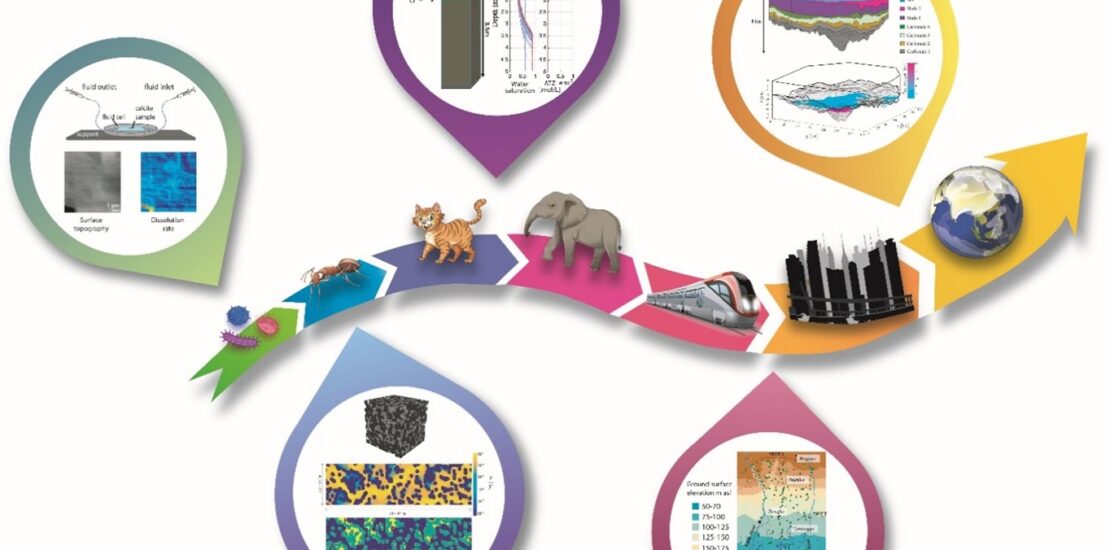
Mi-Pore!: porous media across scales @Polimi
Our research group is based at the Department of Civil and Environmental Engineering at Politecnico di Milano, Italy and we are working on theoretical, computational, and experimental approaches for the characterization of porous materials across a wide range of applications and scales. Let us take you for a brief tour through our most recent research activities, featuring the dynamic characterization of surface processes, multi-scale reactive transport and bio-geochemical processes, and groundwater modelling.
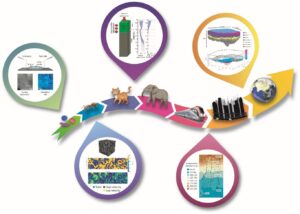
Figure 1. Take a ride across scales with the MI-Pore! group.
Nanoscale characterization of dynamic surface processes
Our journey starts from one of our most recent research streams, which focuses on nanoscale characterization of reactive processes at solid-liquid interfaces. These reactions affect flow and transport phenomena in porous media, as these drive possible alterations of key physical attributes of, e.g., a reservoir/aquifer. Through the SoliNano-Sigma laboratory at Polimi, our recent experimental activity is aimed at exploring the dissolution dynamics on calcite crystals exposed to deionized water. We rely on high-resolution imaging techniques such as Atomic Force Microscopy to collect in-situ and real-time measurements of surface topography of the reacting crystal at the molecular level. These techniques allow detecting the occurrence of diverse dissolution mechanisms, enabling us to quantify the heterogeneity of reaction rates. In this context, our studies on the time evolution of the spatial statistics of rates can provide quantitative insights on the dynamics of the physical mechanisms driving the reaction. For more information check this reference!
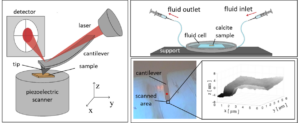
Figure 2. Beyond flatland: The SoliNano experimental facility for nanoscale characterization of dynamic surface processes, see Siena et al. (2021).
Upscaling reactive transport in porous media
Coupled physical, biological and chemical processes often jointly affect mass transport in porous media. Information collected at the scale of individual pores can then be used (in principle) at larger scales. Our group has a strong expertise in reactive transport modeling and in approaches aimed at transferring across scales relevant information to constrain model structure and their parametrization. We rely on both Lagrangian and Eulerian frameworks, which use pore-scale information, to assess system responses emerging at a large scale, such as breakthrough curves, mixing indicators, or plume spreading in porous media. These concepts are applied across a variety of scenarios. Recent works have also targeted transport in the presence of turbulence in porous systems, e.g., across hyporheic regions.
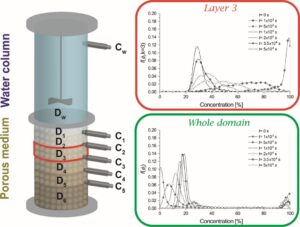
Figure 3 Lagrangian modeling of solute transport and mixing under turbulent flow conditions allows predicting the time-dynamics of the probability density of concentration values, see Baioni et al. (2021) for more details.
Modeling of emerging contaminants in soil and aquifers
What constitute key information to constrain uncertainty in contaminant biodegradation? Can we identify relevant parameters and prioritize data collection for risk assessment? Our current research projects leverage on our expertise of process-based reactive transport modeling to predict and control emerging contaminants across the environment. While targeting specific pharmaceuticals in collaboration with industrial partners, our ongoing or upcoming (recently) funded activities include the REMEDI and RECYCLE EU projects whose aim is to prototype strategies to model the fate of X-Ray contrasting media agents and pesticides in soils and aquifers and, as if that was not enough, to explore the possibility of recycling these precious substances, thus contributing to closing the emerging contaminants cycle. Interested in following the developments? You can get in touch with us through our contact information and even follow RECYCLE on social media!
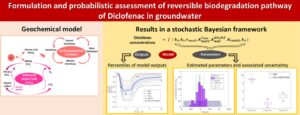
Figure 4. Sometimes they come back: an operational workflow for the characterization of reversible biodegradation of Diclofenac, from Ceresa et al. (2021).
Groundwater modeling under uncertainty
Improved scientific understanding of flow and transport processes and fully embracing uncertainty in its various aspects may be the only realistic approach to handling (qualitatively and quantitatively) integrated hydrological problems with sparse data. Key elements of this important issue were addressed in details by the WE-NEED EU project upon considering two major aquifer systems in Italy, associated with the metropolitan area of Bologna and the city of Cremona, respectively. While the former is a key source of water for the metropolitan area of Bologna (the lower aquifer system provides 80% of all groundwater used for drinking and industrial purposes), the strategic importance of the latter is related to the presence of a high number of natural high-quality water springs which constitute the main supply to agriculture and are key environmental drivers, with significant social, historical and touristic value. As an example of the results we obtained, we assessed the effect of considering alternative conceptual models to represent the spatial arrangement of geomaterials characterizing the internal architecture of the aquifer on groundwater flow and on the quantification of the risk associated with springs depletion due to alternative strategies of aquifer exploitation, these elements constituting major outputs of WE-NEED and being available to local water companies.
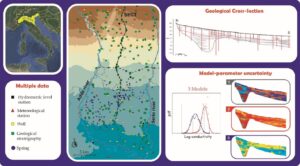
Figure 5. Large scale modeling of groundwater systems in the Po plain area, from Bianchi Janetti et al. (2019).
Sustainable use of underground energy resources
We also focus the appraisal of processes relevant to geo-energy/geo-environmental systems. Main elements of our research in this context include uncertainty quantification in subsurface flow and transport process associated with multiphase flows and targeted to Enhanced Oil Recovery, production allocation, mechanisms of geogenic CO2 generation and geological sequestration, and Environmental risk assessment and footprint of Enhanced Oil Recovery and hydraulic fracturing operations. In addition to being developed in the context of a EU funded project, these activities are strongly supported by industrial partners (e.g., ENI and Geolog).
Porous media across geological ages
Our research also extends to scales that characterize the Earth geological evolution. At these large scales we have developed and applied approaches to constrain the response of sedimentary systems to mechanical and geochemical processes. These activities have often resulted in technology transfer and collaboration with industrial partners, leading to the systematic implementation of probabilistic approaches to full scale problems. Achieving these results was possible only combining expert knowledge with advanced computational and data driven methods.
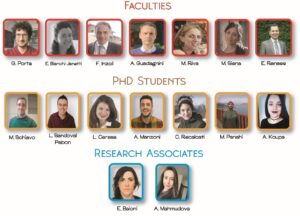
Figure 6. The MI-Pore! group

